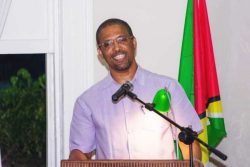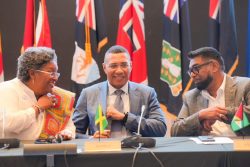Minister of Transport and Hydraulics Robeson Benn and Norwegian Minister of International Development and the Environment, Erik Solheim on Tuesday toured the East Demerara Water Conservancy (EDWC) for a first-hand look at some of the areas most vulnerable to climate change.
According to a Government Information Agency (GINA) press release the tour was hosted one day after the two countries signed an agreement that will enable implementation of the Low Carbon Development Strategy. Benn, Chairman of the Board of the National Drainage and Irrigation Authority Walter Willis, CEO Lionel Wordsworth, Solheim and other officials from Norway also toured sea defence structures at Good Hope, East Coast Demerara. They were given detailed explanations about the structures and their functions.
In an invited comment Solheim told GINA that he now has a good overview of the difficulties which the country faces particularly along the densely populated coastland which is often threatened when sea levels rise and from flooding from the backlands when the EDWC is overburdened. He said although Guyana can be considered a vulnerable state compared to some of the island states in the Caribbean Community he commended the efforts being pursued.
“I am quite impressed with what Guyana is doing, both on the side of reducing emissions through the programme for reduced deforestation, as well as improvement of the dykes here. That is a huge task that cannot be completed in half a year or one year, and it is also expensive for a country with limited resources,” Solheim said. Such challenge, the minister believes is enough reason to support the call for more climate adaptation measures (one of the key recommendations in the new Copenhagen deal in December). He also believes that the recently sealed climate deal between Guyana and Norway will make the necessary finances available to aid in its efforts.
The agreement inked through a MoU will help Guyana accelerate its effort to limit forest-based greenhouse gas emissions and protect its rich rainforest as an asset for the world. Under the agreement Norway will provide financial support to Guyana at a level based on Guyana’s successes in limiting emissions. Financial support from Norway will be channelled through the Guyana REDD (Reduced Emissions from Deforestation and forest Degradation) +Investment Fund. Provided that the expected results are achieved and that other elements of the partnership fall into place, financial support for the years up to 2015 could yield up to US$250M, GINA said.
One of the imminent projects is to build an outfall channel at Hope that will be of enough capacity to relieve the pressure on the conservancy. Meanwhile, heavy reliance has been on sea defence, drainage and irrigation structures and mangroves to protect the coastland from the Atlantic. Extreme events such as hurricanes have however, resulted in erosion of the earthen embankment, mud ripples along the coast and uprooting of the mangroves. Over the years government has spent about US$30M for capital and rehabilitation works for sea defence, some of which has been supported by the Inter-American Development Bank, the UK Department for International Development and the Caribbean Development Bank.
Benn explained that several impact assessment studies have been done in the past to estimate the rate of water level rise and have proven that there is need for an elevation in sea defences by at least one metre over the next ten years to be able to effectively manage the problem. The projections are being re-evaluated, GINA said.








